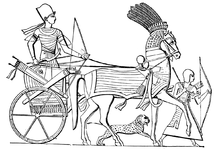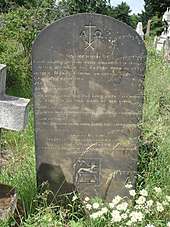Joseph Bonomi the Younger
Joseph Bonomi the Younger (9 October 1796 – 3 March 1878) was an English sculptor, artist, Egyptologist and museum curator.
Joseph Bonomi | |
|---|---|
 Portrait of Joseph Bonomi the Younger by Matilda Sharpe, 1868 | |
| Born | 9 October 1796 London |
| Died | 3 March 1878 (aged 81) |
| Nationality | British |
| Education | Charles Bell |
Early life
Bonomi was born in London into a family of architects. His father, Joseph Bonomi the Elder, had worked with Robert and James Adam, while his older brother, Ignatius Bonomi, was a notable architect of the early and mid-19th century.
The Hay expedition
Bonomi studied under Charles Bell at the Royal Academy,[1] and in 1822 went to Rome to study under Antonio Canova, who died in October before Bonomi arrived. Nonetheless, Bonomi studied in Rome for several months but got into debt and was eventually happy to accept a modestly paid commission to accompany Robert Hay on an expedition, via Malta, to Egypt in 1824.[2] This began a lifelong interest in Egyptology.
From 1824 to 1826, he was a member of Hay's expedition where he sketched many antiquities. At Abu Simbel in 1825, Bonomi – responding to Hay's demands for great accuracy – devised a drawing frame (a viewfinder-type device equipped with a sight and a string or wire grid) to help them draw the temples' interior decorations. The expedition then moved on to Kalabsha, where Bonomi laboured to produce several plaster casts of the reliefs, to Philae and then to Thebes.
However, Bonomi's relationship with Hay was stormy. Bonomi was frustrated at what he regarded as a low salary; Hay resented Bonomi's wish to enhance his own reputation by producing drawings and casts for himself. In July 1826, Bonomi resigned (and was replaced as Hay's assistant by Edward William Lane).
In Cairo (1827–1828), Bonomi illustrated James Burton's Excerpta hieroglyphica. In July 1832, with his finances now more stable, he met Hay again, at Asyut, and was persuaded to rejoin his team (at a much higher salary) along with a French artist, Dupuy.
After Hay left Egypt in 1834, Bonomi undertook tours of Syria and Palestine (with Francis Arundale and Frederick Catherwood). In 1839 he prepared illustrations for Sir John Gardiner Wilkinson's Manners and Customs of the Ancient Egyptians.
Architectural diversions
No doubt influenced by his family's architectural associations, Bonomi designed the entrance to Abney Park Cemetery in Stoke Newington, London (in collaboration with William Hosking), built in Egyptian style with hieroglyphics signifying the Abode of the Mortal Part of Man. He also designed an Egyptian facade for John Marshall's Temple Works in Leeds (opened in 1841). The latter was undertaken shortly before Bonomi returned to Egypt as part of a Prussian expedition (1842–1844) led by Karl Richard Lepsius.[2] An 'Egyptian Spring' in Hartwell, Buckinghamshire was designed by Bonomi in 1850 for Dr John Lee of Hartwell House.
Work in England
On his return to England, Bonomi married Jessie Martin, daughter of artist John Martin (1789–1854), in 1844.

Now based in London, Bonomi's work included cataloguing and illustrating many Egyptian collections (including that of Samuel Birch); he also set up with Owen Jones the Egyptian Court at The Crystal Palace,[3] when it was rebuilt at Sydenham in 1854, and helped to arrange the Egyptian exhibits in the British Museum in London.
He published Nineveh and its Palaces and works on Egypt, Nubia, and Ethiopia, illustrated with his own drawings.[3]
In 1861, Bonomi applied to become curator of the Sir John Soane's Museum. As this was normally a post awarded to a practising architect, he was only appointed after a fierce struggle and much criticism.
With his brother Ignatius, he built a house, The Camels, at Wimbledon in south-west London. He also invented a machine for measuring the proportions of the human body, and wrote a treatise, The Proportion of the Human Figure published in 1856.
Later life
He died at The Camels in Wimbledon in March 1878 and was buried in Brompton Cemetery.[4]
Personal life
He married Jessie Martin (6 April 1825 – 10 September 1859), daughter of the artist John Martin. They had twelve children, the first four of which died of whooping cough.
Speculation

It has been said that he may have had a connection to the mysterious Hannah Courtoy, who possibly funded some of his expeditions and that he may have been behind the design of her Egyptian style tomb which proudly stands just a stones throw from his own modest grave.
Notes
-

- Lane-Poole 1886.
- Bryan 1886.
- "Archived copy". Archived from the original on 23 August 2006. Retrieved 21 August 2007.CS1 maint: archived copy as title (link)
References
- Lane-Poole, Stanley (1886). . In Stephen, Leslie (ed.). Dictionary of National Biography. 5. London: Smith, Elder & Co.
- Bryan, Michael (1886). "Bonomi, Joseph". In Robert Edmund Graves (ed.). Dictionary of Painters and Engravers, Biographical and Critical (Volume I: A-K). York St. No. 4, Covent Garden, London; Original from Fogg Library, Digitized 18 May 2007: George Bell and Sons. p. 156.CS1 maint: location (link)